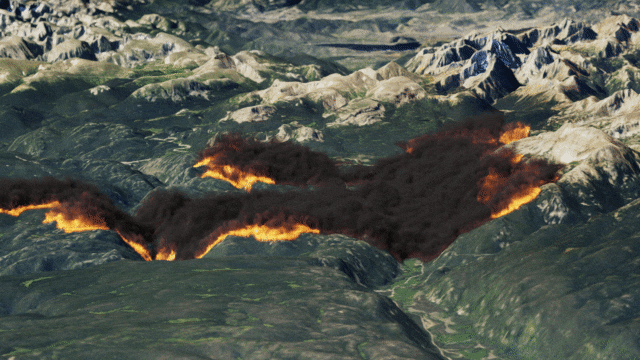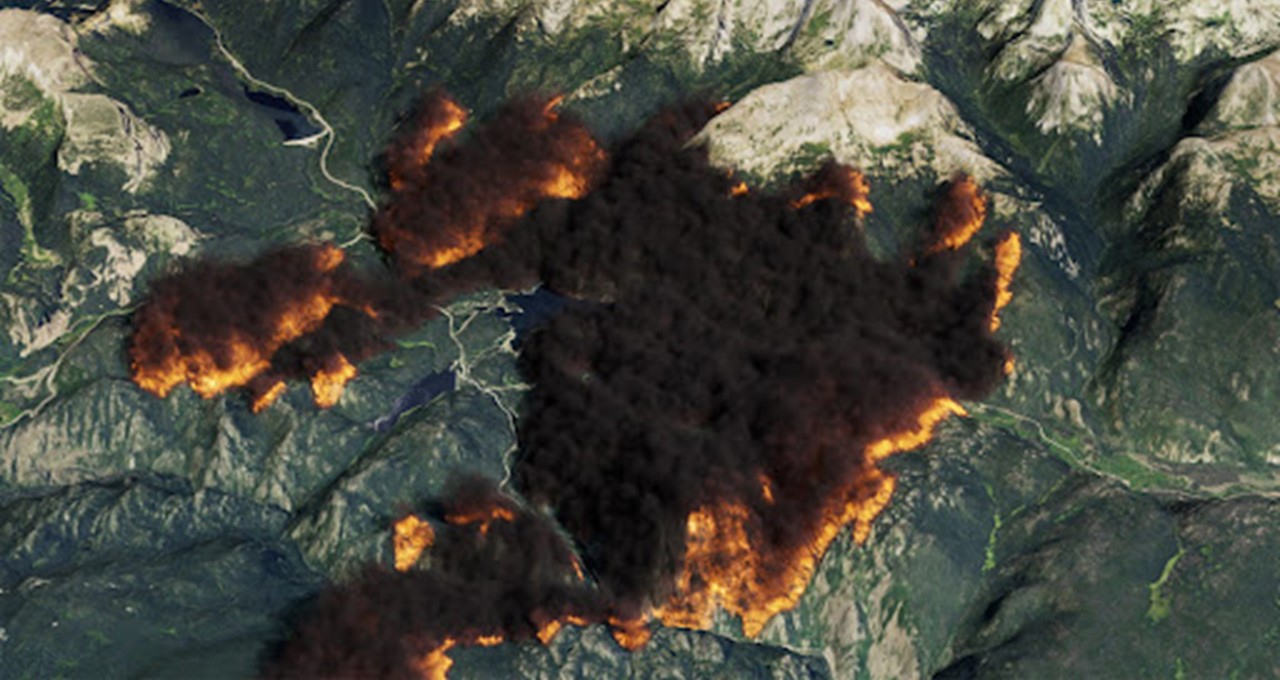Intense wildfires fueled by warmer, drier weather have swept across enormous swaths of forest worldwide, causing nearly $20 billion in damage in the Western U.S. alone last year, according to one estimate.
To better understand wildfires and stop their spread, NVIDIA and Lockheed Martin are announcing today that we are working with the U.S. Department of Agriculture Forest Service and Colorado Division of Fire Prevention & Control (DFPC) using AI and digital-twin simulation.
The companies are also announcing that we are building the world’s first AI-centric lab dedicated to predicting and responding to wildfires. The lab will use NVIDIA AI infrastructure and the NVIDIA Omniverse advanced visualization and virtual world simulation platform to process a fire’s magnitude and forecast its progress. By recreating the fire in a physically accurate digital twin, the system will be able to suggest actions to best suppress the blaze.
While wildfires have torn through more than 6.5 million acres in the U.S. so far this year, the problem is far broader than that. Vastly more land has been scorched in Siberia, and epic blazes have swept through the Mediterranean region and Australia.
New Silicon Valley Lab
The AI development lab, to be based in Silicon Valley, will include Lockheed Martin’s Cognitive Mission Manager (CMM) system, an end-to-end AI-driven planning and orchestration platform, that combines real-time sensor data about the fire with other data sources on fuel vegetation, topography, wind and more to predict the fire’s spread. The CMM provides course-of-action recommendations to the incident command teams to decrease response time and increase effectiveness of wildfire suppression and humanitarian actions.
The lab will serve as an open collaboration space for industry and users to concentrate talent and resources for CMM design and rapidly develop prototypes in NVIDIA Omniverse. Lockheed Martin is providing domain expertise in applied AI, platform integration, planning and oversight as well as several dozen application engineers and data scientists. NVIDIA is contributing data analysis and simulation expertise to help develop, model, test and deploy in the lab.
To crunch the data and train AI models, Lockheed Martin uses NVIDIA DGX systems. To visualize the fires and predict how they might spread, Lockheed Martin uses NVIDIA Omniverse Enterprise.
“The combination of Lockheed Martin and NVIDIA technology has the potential to help crews respond more quickly and effectively to wildfires while reducing risk to fire crews and residents,” said Shashi Bhushan, Principal AI Architect at Lockheed Martin.
Visualizing the Flames Using a Digital Twin
NVIDIA Omniverse allows fire behavior analysts to see the predictions in a digital twin of the environment. Using the real-time, multi-GPU scalable simulation platform, Lockheed Martin creates visualizations of the predicted fire movements and studies their flow dynamics across a digital replica of the landscape. This enables its team to utilize NVIDIA Omniverse in multiple areas.
The fire control industry primarily relies on tools derived from the Rothermel surface fire spread model to predict fire progression. The team at Lockheed Martin is working with the group that created this model, the Forestry Service Missoula Fire Sciences Lab, to examine how AI can improve upon existing methods of fire front prediction with speed and accuracy.
With NVIDIA Omniverse, the team at Lockheed Martin can accelerate training, development, and evaluation of new AI models by recreating historical fires using real data, in addition to representing how the Rothermel model and the CMM algorithms would predict the fire. This enables the engineers to simultaneously compare how historical fire progressed relative to both models’ predictions.
NVIDIA Omniverse also provides an immersive digital twin environment for emergency responders, operators, and engineers to evaluate the impact of their suppression activities.
“In Omniverse, you’ve got a virtual world that represents a photorealistic digital environment. In it, we can visualize the fires and aspects that affect them, like the terrain, slope, wind and more,” said Bhushan. “In the near future, we could generate synthetic data by flying virtual assets through the Omniverse scene. Additionally, the Omniverse simulation becomes the foundation to create additional AI based models to explore response behaviors.”

The Lockheed Martin engineers working on CMM aim to integrate the technology into aircraft cockpits to display fire predictions and suggest a course of action for suppression in real time.
Working With U.S. and Colorado Fire Management Agencies
The USDA Forest Service Missoula Fire Sciences Laboratory, in Montana, which conducts cutting-edge work in wildland fire research, has been providing applications, data, software and products to aid in fire analysis and simulation. The lab has developed the FARSITE wildfire growth and behavior prediction tool using the Rothermel surface fire spread model. The lab has provided the Lockheed Martin team with critical expertise on fire behavior and historical data.
The Colorado Division of Fire Prevention & Control (DFPC) is a partner and early adopter of CMM AI technologies being developed by Lockheed Martin and NVIDIA. DFPC provides expertise, user experience and feedback, and platform integration with real time data collection. The Lockheed Martin team is embedded with the Multi-Mission Aircraft program team to participate in operations and collect data on Colorado fires directly from the Multi-Mission Aircraft mapping them. Colorado Fire is also providing historical fire data for modeling visualizations in NVIDIA Omniverse. Through this continued partnership Lockheed Martin engineers will be able to process data and make predictions through the CMM from an active wildfire observed by the aircraft in real time to assist the onboard fire responders.
Lockheed Martin and NVIDIA will continue to collaborate, both physically and within the digital twin environment, to develop and mature CMM. One day, uncrewed aerial vehicles will rapidly respond to and suppress emerging wildfires.
At NVIDIA GTC, taking place online through Nov. 11, the CMM team will talk about how NVIDIA Omniverse is being used to showcase fire movement predictions based on traditional methods versus the CMM system’s algorithm. To learn more, tune into Lockheed Martin’s GTC session.
Watch NVIDIA CEO Jensen Huang’s GTC keynote:
